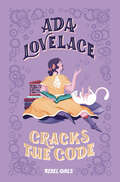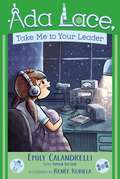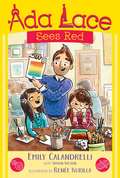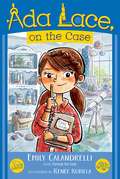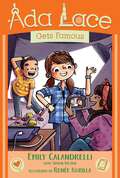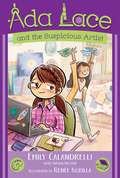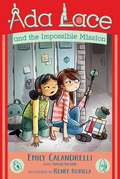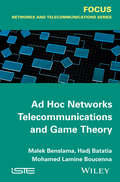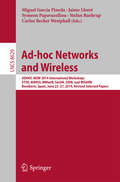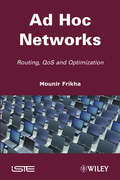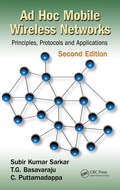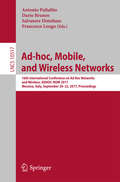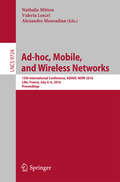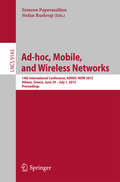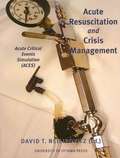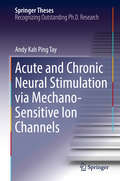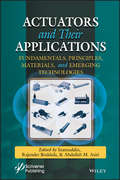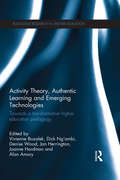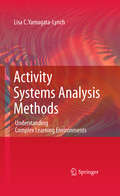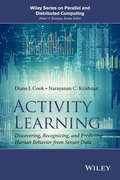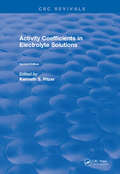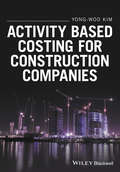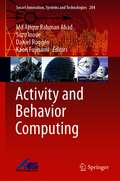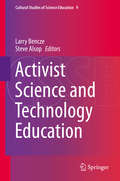- Table View
- List View
Ada Lovelace Cracks the Code (Rebel Girls Chapter Books)
by Rebel Girls Corinne PurtillFrom the world of Good Night Stories for Rebel Girls comes a story based on the exciting real-life adventures of Ada Lovelace, one of the world's first computer programmers.Growing up in nineteenth century London, England, Ada is curious about absolutely everything. She is obsessed with machines and with creatures that fly. She even designs her own flying laboratory!According to her mother, Ada is a bit too wild, so she encourages Ada to study math. At first Ada thinks: Bleh! Who can get excited about a subject without pictures? But she soon falls in love with it. One day she encounters a mysterious machine, and from that moment forward Ada imagines a future full of possibility-one that will eventually inspire the digital age nearly two hundred years later.Ada Lovelace Cracks the Code is the story of a pioneer in the computer sciences, and a testament to women's invaluable contributions to STEM throughout history.This historical fiction chapter book also includes additional text on Ada Lovelace's lasting legacy, as well as educational activities designed to teach simple coding and mathematical concepts.About the Rebel Girls Chapter Book SeriesMeet extraordinary real-life heroines in the Good Night Stories for Rebel Girls chapter book series! Introducing stories based on the lives and times of extraordinary women in global history, each stunningly designed chapter book features beautiful illustrations from a female artist as well as bonus activities in the backmatter to encourage kids to explore the various fields in which each of these women thrived. The perfect gift to inspire any young reader!
Ada Lace, Take Me to Your Leader: Ada Lace, On The Case; Ada Lace Sees Red; Ada Lace, Take Me To Your Leader; Ada Lace And The Impossible Mission (An Ada Lace Adventure #3)
by Emily Calandrelli Renée Kurilla Tamson WestonFrom Emily Calandrelli—host of Xploration Outer Space, correspondent on Bill Nye Saves the World, and graduate of MIT—comes the third novel in a fun illustrated chapter book series about an eight-year-old girl with a knack for science, math, and solving mysteries with technology.Third grader and inventor extraordinaire Ada Lace likes nothing more than to tinker with mechanics like her robot, George. Her latest project is to fix up a ham radio, something that she could use to contact people on this planet…and beyond. The only problem is that she just can’t get it to work properly. During a sleepover, Ada’s best friend Nina hears something strange coming from the radio in the middle of the night. A distant voice says, “Release the swarm!” convincing Nina that aliens are about to invade planet Earth. Could Ada and Nina have stumbled upon something…extraterrestrial?
Ada Lace Sees Red
by Emily Calandrelli Renée Kurilla Tamson WestonFrom Emily Calandrelli—host of Xploration Outer Space, correspondent on Bill Nye Saves the World, and graduate of MIT—comes the second novel in a brand-new chapter book series about an eight-year-old girl with a knack for science, math, and solving mysteries with technology.Ada Lace is building a new robot! She’s determined to beat Milton in the upcoming robotics competition. But she’s distracted—Ada finds her dad’s art class impossible, while Nina is the star of the class, basking in the glory of being Mr. Lace’s star pupil. When Mr. Lace suggests that Nina put on an art show, Ada becomes jealous and loses her temper. Now Ada isn’t speaking to her dad, she’s falling behind in art class, and she still doesn’t know how to fix her robot. As the competition looms closer, Ada starts to wonder if there might be a way to use both science and art to solve her problems. Will Ada make up with her father in time to test her hypothesis? Or will her hurt feelings leave her seeing red and without a medal at the end of the day?
Ada Lace, on the Case (An Ada Lace Adventure #1)
by Emily CalandrelliFrom Emily Calandrelli—host of Xploration Outer Space, correspondent on Bill Nye Saves the World, and graduate of MIT—comes the first novel in a brand-new chapter book series about an eight-year-old girl with a knack for science, math, and solving mysteries with technology.Ada Lace—third-grade scientist and inventor extraordinaire—has discovered something awful: her neighbor&’s beloved Yorkie has been dognapped! With the assistance of a quirky neighbor named Nina (who is convinced an alien took the doggie) and her ever-growing collection of gadgets, Ada sets out to find the wrongdoer. As their investigation becomes more and more mysterious, Ada and Nina grow closer, proving that opposites do, in fact, attract.
Ada Lace Gets Famous (An Ada Lace Adventure #6)
by Emily CalandrelliFrom Emily Calandrelli—Emmy-nominated host of Xploration Outer Space, host of Netflix&’s Emily&’s Wonder Lab, and graduate of MIT—comes the sixth novel in a fun illustrated chapter book series about an eight-year-old girl with a knack for science, math, and solving mysteries with technology.When third grader and inventor extraordinaire Ada Lace learns her teachers are in dire need of new school supplies, she&’s eager to lend a helping hand—but how? With a bake sale? A class carnival? Most ideas seem out of reach for a kid like her, until Tycho suggests Ada try her hand at posting informational videos. If she&’s able to build up a big online viewership, she could easily raise funds for their school. And with Nina as her visionary director, Milton as her comedic cohost, and Ada as the scientist star, making fun videos will be a piece of cake! Or so they think. What starts as an earnest try at making fun, science-based shorts ends up being a whole mess for Ada and the gang as they gain popularity and take on peer pressure, trolls, and tests of their friendships. With her rising internet stardom, will Ada be able to stay true to herself?
Ada Lace and the Suspicious Artist (An Ada Lace Adventure #5)
by Emily Calandrelli Renée Kurilla Tamson WestonFrom Emily Calandrelli—Emmy-nominated host of Xploration Outer Space, correspondent on Bill Nye Saves the World, and graduate of MIT—comes the fifth novel in a fun illustrated chapter book series about an eight-year-old girl with a knack for science, math, and solving mysteries with technology.Third grader and inventor extraordinaire Ada Lace is on spring break. But it’s just a little less relaxing than she’d imagined. Nina is beside herself with excitement about meeting her favorite artist and enlists Ada and Mr. Peebles’s coding-whiz nephew to help revamp her online portfolio. When Nina finally meets Miroir, he snubs her, and her confidence is shaken—but not enough to miss the art show opening. While there, Ada spots a suspiciously familiar painting that may mean Miroir isn’t the original he claims to be. Will the friends be able to reveal the artist’s true nature, before he fools someone else?
Ada Lace and the Impossible Mission: Ada Lace, On The Case; Ada Lace Sees Red; Ada Lace, Take Me To Your Leader; Ada Lace And The Impossible Mission (An Ada Lace Adventure #4)
by Emily Calandrelli Renée Kurilla Tamson WestonFrom Emily Calandrelli—Emmy-nominated host of Xploration Outer Space, correspondent on Bill Nye Saves the World, and graduate of MIT—comes the fourth novel in a fun illustrated chapter book series about an eight-year-old girl with a knack for science, math, and solving mysteries with technology.Third grader and inventor extraordinaire Ada Lace has a new social studies teacher—who loves group projects. While most of the class has constructed regular dioramas with clay and construction paper, Ada, her best friend Nina, and sometimes nemesis Milton have built a complex scale model of an historic silver mine. But when Milton reveals that he added his “old Milton touch” on their project right before turning it in, Ada worries that he has sabotaged their work. In a desperate attempt to save their project, Ada and Nina use their combined creative and technical prowess to perform a heist and break into their teacher’s supply closet after school. Do the two friends have what it takes to deceive the school’s security system? Or will they get caught trying to pull off this seemingly impossible mission.
Ad Hoc Networks Telecommunications and Game Theory
by Malek Benslama Hadj Batatia Mohamed Lamine BoucennaRandom SALOHA and CSMA protocols that are used to access MAC in ad hoc networks are very small compared to the multiple and spontaneous use of the transmission channel. So they have low immunity to the problems of packet collisions. Indeed, the transmission time is the critical factor in the operation of such networks.The simulations demonstrate the positive impact of erasure codes on the throughput of the transmission in ad hoc networks. However, the network still suffers from the intermittency and volatility of its efficiency throughout its operation, and it switches quickly to the saturation zone. In this context, game theory has demonstrated his ability to lead the network to a more efficient equilibrium. This, we were led to propose our model code set that formalizes the behavior of nodes during transmission within SALOHA networks and CSMA respectively
Ad-hoc Networks and Wireless: ADHOC-NOW 2014 International Workshops, ETSD, MARSS, MWaoN, SecAN, SSPA, and WiSARN, Benidorm, Spain, June 22--27, 2014, Revised Selected Papers (Lecture Notes in Computer Science #8629)
by Miguel Garcia Pineda Jaime Lloret Symeon Papavassiliou Stefan Ruehrup Carlos Becker WestphallThis book constitutes the refereed proceedings of six workshops collocated with the 13th International Conference on Ad-Hoc Networks and Wireless, ADHOC-NOW Workshops 2014, held in Benidorm, Spain, in June 2014. The 25 revised full papers presented were carefully reviewed and selected from 59 submissions. The papers address the following topics: emerging technologies for smart devices; marine sensors and systems; multimedia wireless ad hoc networks; security in ad hoc networks; smart sensor protocols and algorithms; wireless sensor, actuator and robot networks.
Ad Hoc Networks: Routing, Qos and Optimization
by Mounir FrikhaThis work presents ad hoc networks and their characteristics. It explains a new protocol of routing with QoS as well as its implementation in a network simulator and compares it with the existing protocols. The book discusses the principle of the load balancing, treats the approaches of optimization of energy, and proposes a new approach with an analytical model that gives a better performance.
Ad Hoc Mobile Wireless Networks: Principles, Protocols, and Applications, Second Edition
by Subir Kumar Sarkar T.G. Basavaraju C. PuttamadappaThe military, the research community, emergency services, and industrial environments all rely on ad hoc mobile wireless networks because of their simple infrastructure and minimal central administration. Now in its second edition, Ad Hoc Mobile Wireless Networks: Principles, Protocols, and Applications explains the concepts, mechanism, design, and
Ad-hoc, Mobile, and Wireless Networks: 16th International Conference on Ad Hoc Networks and Wireless, ADHOC-NOW 2017, Messina, Italy, September 20-22, 2017, Proceedings (Lecture Notes in Computer Science #10517)
by Dario Bruneo Salvatore Distefano Antonio Puliafito Francesco LongoThis book constitutes the refereed proceedings of the 16th International Conference on Ad-hoc, Mobile, and Wireless Networks, ADHOC-NOW 2017, held in Messina, Italy, in September 2017. The 22 full and 9 short papers presented in this volume were carefully reviewed and selected from 55 submissions. The contributions were organized in topical sections named: internet of things; security; smart city; ad-hoc networks; implementations and validations; wireless sensor networks; data management; wireless systems.
Ad-hoc, Mobile, and Wireless Networks: 15th International Conference, ADHOC-NOW 2016, Lille, France, July 4-6, 2016, Proceedings (Lecture Notes in Computer Science #9724)
by Valeria Loscri Nathalie Mitton Alexandre MouradianThis book constitutes the proceedings of the 15th International Conference on Ad Hoc Networks and Wireless, ADHOC-NOW 2016, held in Lille, France in July 2016. The 23 full papers presented together with one short paper in this volume were carefully reviewed and selected from 64 submissions. The contributions are organized in topical sections named: resource allocation, theory and communications, PHY/MAC/routing in sensors/IoT, DTN/opportunistic networks, sensors/IoT, security, VANET and ITS, and robots and MANETs.
Ad-hoc, Mobile, and Wireless Networks: 14th International Conference, ADHOC-NOW 2015, Athens, Greece, June 29 -- July 1, 2015, Proceedings (Lecture Notes in Computer Science #9143)
by Symeon Papavassiliou Stefan RuehrupThis book constitutes the proceedings of the 14th International Conference on Ad Hoc Networks and Wireless, ADHOC-NOW 2015, held in Athens, Greece in June/July 2015. The 25 full papers presented in this volume were carefully reviewed and selected from 52 submissions. The book also contains 3 full-paper invited talks. The contributions are organized in topical sections named: routing, connectivity, and resource allocation; localization, sensor deployment, and mobility management; distributed computing with mobile agents; efficient, reliable, and secure smart energy networks; and emerging communications, networking and computing technologies for VANETs 2. 0.
Acute Resuscitation and Crisis Management: Acute Critical Events Simulation (ACES)
by David T. NeilipovitzThis book is a compendium to the ACES Program, containing its important background information and reference material while serving as an independent reference source for physicians and other health care professionals.
Acute Exposure Guideline Levels for Selected Airborne Chemicals
by Committee on Acute Exposure Guideline LevelsThe Bhopal Disaster of 1984 resulted in the death of around 2,000 residents living near chemical plants and irreversible injuries to more than 20,000 other residents. These numbers can be attributed to the community's lack of awareness concerning the chemicals' existence, dangers and effects, and/or how to react in case of emergency. The disaster emphasized the need for governments to identify hazardous substances and to aid local communities in developing plans for emergency exposures. As a result, the United States government issued the Superfund Amendments and Reauthorization Act (SARA) of 1986; requiring the identification of extremely hazardous substances (EHSs) by the Environmental Protection Agency (EPA). EPA was also tasked with assisting Local Emergency Planning Committees (LEPCs) in conducting health-hazard assessments to develop emergency-response plans for sites where EHSs are produced, stored, transported, or used. The EPA identified nearly 400 EHSs in terms of their immediate danger to life and health (IDLH) as their first step in assisting these LEPCs. In 1991 the EPA went on to request that the National Research Council (NRC) Committee on Toxicology (COT) develop criteria and methods for developing emergency exposure levels for EHSs for the general population. The COT, who had published many reports on emergency exposure guidance levels at the time, designated the task to a subcommittee. The subcommittee focused on Guidelines for Developing Community Emergency Exposure Levels for Hazardous Substances. Four years later the National Advisory Committee for Acute Exposure Guideline Levels for Hazardous Substances (NAC) was created with a focus on identifying, reviewing, and interpreting relevant toxicologic and other scientific data and developing acute exposure guideline levels (AEGLs) for high-priority, acutely toxic chemicals. In Acute Exposure Guideline Levels for Selected Airborne Chemicals: Volume 4, the NAC outlines acute exposure guideline levels for chlorine, hydrogen chloride, toluene 2,4, hydrogen fluoride, 2,6-diisocyanate, and uranium hexafluoride.
Acute and Chronic Neural Stimulation via Mechano-Sensitive Ion Channels (Springer Theses)
by Andy Kah Ping TayThis book describes the tools, developed by the author, for perturbing endogenous mechano-sensitive ion channels for magneto-mechanical neuro-modulation. He explores the ways in which these tools compare against existing ones such as electricity, chemicals, optogenetics, and techniques like thermos/magneto-genetics. The author also reports on two platforms--magnetic ratcheting and magnetic microfluidics for directed evolution and high throughput culture of magnetotactic bacteria--that produce high quality magnetic nanoparticles for biomedical applications like neural stimulations. This thesis was submitted to and approved by the University of California, Los Angeles.
Actuators and Their Applications: Fundamentals, Principles, Materials, and Emerging Technologies (Materials Research Foundations Ser.)
by Rajender Boddula Inamuddin Abdullah M. AsiriAs demand has increased for new types of equipment that are more suited to the ever-evolving world of industry, demand for both new and traditional types of actuators has soared. From automotive and aeronautical to biomedical and robotics, engineers are constantly developing actuating devices that are adapted to their particular needs in their particular field, and actuators are used in almost every field of engineering that there is. This volume not only lays out the fundamentals of actuators, such as how they operate, the different kinds, and their various applications, but it also informs the engineer or student about the new actuators that are being developed and the state-of-the-art of actuators. Edited and written by highly experienced and well-respected engineers with a deep understanding of their subject, there is no other volume on actuators that is more current or comprehensive. Whether as a guide for the latest innovations in actuators, a refresher reference work for the veteran engineer, or an introductory text for the engineering student, this is a must-have for any engineer’s or university’s library. Covering the theory and the practical applications, this breakthrough volume is a “one stop shop” for any engineer or student interested in actuators.
Activity Theory, Authentic Learning and Emerging Technologies: Towards a transformative higher education pedagogy (Routledge Research in Higher Education)
by Denise Wood Vivienne Bozalek Dick Ng’ambi Jan Herrington Joanne Hardman Alan AmoryAlthough emerging technologies are becoming popularised for teaching, learning and research, the relationship between their use and transformative effects on higher education remain largely unexplored. This edited collection seeks to fill this gap by providing a nuanced view, locating higher education pedagogical practices at an intersection of emerging technologies, authentic learning and activity systems. Providing numerous case studies as examples, the book draws from a wide range of contexts to illustrate how such a convergence has the potential to track transformative teaching and learning practices in the higher education sector. Chapters provide the reader with a variety of transformative higher education pedagogical practices in southern contexts, theorised within the framework of Cultural Historical Activity Theory (CHAT) and tool mediation, while using authentic learning as a pedagogical model upon which this theoretical framework is based. The topics covered in the book have global relevance, with research paying particular attention to South Africa, Australia and New Zealand, where the authors are based. The book will be of interest to educators, researchers and practitioners in higher education, as well as those interested in emerging technologies in education more generally.
Activity Systems Analysis Methods: Understanding Complex Learning Environments
by Lisa C. Yamagata-LynchIn the last two decades, there has been growing interest in pursuing theoretical paradigms that capture complex learning situations. Cultural Historical Activity Theory (CHAT) is one of several theoretical frameworks that became very popular among educational researchers because it conceptualizes individuals and their environment as a holistic unit of analysis. It assumes a non-dualistic ontology and acknowledges the complexities involved in human activity in natural settings. Recently, reputable journals such as the American Psychologist, Educational Psychologist, and Educational Researcher that are targeted for a wide-range of audience have included articles on CHAT. In many of such articles, CHAT has been referred to as social constructivism, sociocultural theory, or activity theory. Activity systems analysis is one of the popular methods among CHAT researchers for mapping complex human interactions from qualitative data. However, understanding the methods involved in activity systems analysis is a challenging task for many researchers. This difficulty derives from several reasons. First the original texts of CHAT are in Russian and there have been numerous authors who report on the difficulties of reconciling translation problems of the works of original authors' such as Vygotsky and Leontiev. Second, in North America activity systems analysis has deviated from the Russian scholars' intentions and Engeström's original work using the triangle model to identify tensions to overcome and bring about sociopolitical change in participant practices. Third, to this date there are numerous publications on the theoretical background of activity theory and studies reporting the results of using activity systems analysis for unpacking qualitative data sets, but there have been no methodological publications on how researchers engage in activity systems analysis. Thus, there is a dearth of literature in both book and journal publications that guide researchers on the methodological issues involving activity systems analysis.
Activity Learning
by Narayanan C. Krishnan Diane J. CookDefines the notion of an activity model learned from sensor data and presents key algorithms that form the core of the field Activity Learning: Discovering, Recognizing and Predicting Human Behavior from Sensor Data provides an in-depth look at computational approaches to activity learning from sensor data. Each chapter is constructed to provide practical, step-by-step information on how to analyze and process sensor data. The book discusses techniques for activity learning that include the following: Discovering activity patterns that emerge from behavior-based sensor data Recognizing occurrences of predefined or discovered activities in real time Predicting the occurrences of activities The techniques covered can be applied to numerous fields, including security, telecommunications, healthcare, smart grids, and home automation. An online companion site enables readers to experiment with the techniques described in the book, and to adapt or enhance the techniques for their own use.With an emphasis on computational approaches, Activity Learning: Discovering, Recognizing, and Predicting Human Behavior from Sensor Data provides graduate students and researchers with an algorithmic perspective to activity learning.
Activity Coefficients in Electrolyte Solutions
by Kenneth S. PitzerThis book was first published in 1991. It considers the concepts and theories relating to mostly aqueous systems of activity coefficients.
Activity Based Costing for Construction Companies
by Yong-Woo KimActivity Based Cotsting for Construction Companies provides guidelines on how overhead costs can be managed for using Activity Based Costing (ABC), providing gains in contractor competiveness. Illustrated with a range of case studies and examples it also presents a map that shows construction contractors how to implement ABC to calculate overhead costs accurately, identifying non or low-value added operations which can then be improved.
Activity and Behavior Computing (Smart Innovation, Systems and Technologies #204)
by Md Atiqur Rahman Ahad Sozo Inoue Daniel Roggen Kaori FujinamiFocusing on the vision-based and sensor-based recognition and analysis of human activity and behavior, this book gathers extended versions of selected papers presented at the International Conference on Activity and Behavior Computing (ABC 2020), held in Kitakyushu, Japan on August 26 – 29, 2020. The respective chapters cover action recognition, action understanding, gait analysis, gesture recognition, behavior analysis, emotion and affective computing, and related areas. The book addresses various challenges and aspects of human activity recognition in both the sensor-based and vision-based domains, making it a unique guide to the field.
Activist Science and Technology Education (Cultural Studies of Science Education #9)
by Larry Bencze Steve AlsopThis collection examines issues of agency, power, politics and identity as they relate to science and technology and education, within contemporary settings. Social, economic and ecological critique and reform are examined by numerous contributing authors, from a range of international contexts. These chapters examine pressing pedagogical questions within socio-scientific contexts, including petroleum economies, food justice, health, environmentalism, climate change, social media and biotechnologies. Readers will discover far reaching inquiries into activism as an open question for science and technology education, citizenship and democracy. The authors call on the work of prominent scholars throughout the ages, including Bourdieu, Foucault, Giroux, Jasanoff, Kierkegaard, Marx, Nietzsche, Rancière and Žižek. The application of critical theoretical scholarship to mainstream practices in science and technology education distinguishes this book, and this deep, theoretical treatment is complemented by many grounded, more pragmatic exemplars of activist pedagogies. Practical examples are set within the public sphere, within selected new social movements, and also within more formal institutional settings, including elementary and secondary schools, and higher education. These assembled discussions provide a basis for a more radically reflexive reworking of science and technology education. Educational policy makers, science education scholars, and science and technology educators, amongst others, will find this work thought-provoking, instructive and informative.
